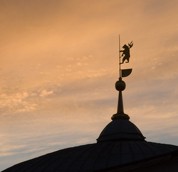Yaroslavl Front Door #4: Sobinova street, 48
We continue our series of Yaroslavl front doors which made by LJ user yanlev. One of our readers complained of bad photo quality, so I've decided to correct some of yanlev's photographs. Possible in the future we will take photos on our own.

It's Sakin's rented apartment house. This building was built in 1907 year. Mikhail Sakin was a famous Yaroslavl supporter (patron). In 1880s his father founded a weaving mill nearby the city. Today it is Krasnye tkachi (Красные ткачи). Mikhail liked the mill and worked a lot but ungrateful workers had been being on strike for two weeks.
After that incident he decided to give up the mill and take up his apartment house on Netecha street (ул. Нетеча). It's Sobinova street (ул. Собинова) now.
The door.

The door is modern but simple and fits into the facade.

This vertical implements three functions: the entrance, the living room and the balcony.
The staircase.

The staircase remains intact. And judging by carpet holders we can see that it was restored and not only one time.

Pay attention on staircase legs: they are in a Art Nouveau style. This pattern is a "classic" Art Nouveau.

The landing.

Go outdoor...

There is a big window with handsome frames on the first floor.

And it is a great example of an Art Nouveau window:


The landing is spacious and neat but not light. This narrow windows give little light. But Sakin was one of the first who used elictricity in 1907 year.
The trick.

It is an original door of 1900s!

And whole building has one style:


Wednesday, May 27, 2009 in Story. You can comment (we have one response).







We Have One Comment
James Boekbinder
Beautiful report! These kinds of houses remind us of the largely untold history of early Russian industrial capitalism, beyond a few of the big names like Morozov. The book 'Merchant Moscow' (West and Petrov) discusses the way that architectural motifs were deployed to lend legitimacy to the status of 'business person', which had (and still has) less positive connotations than in Western Europe and the US. It came to mind while reading this report.
September 27, 2009 at 1:02 PM
Post a Comment